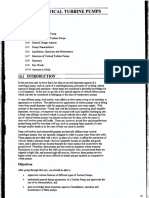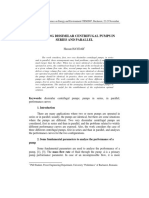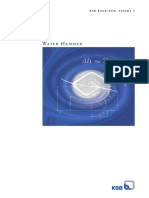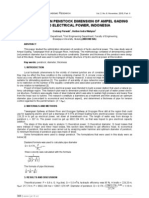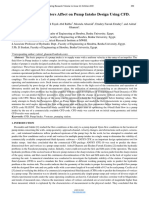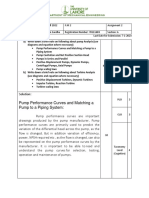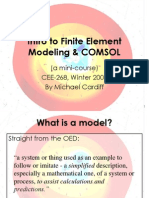AFT-Four Quadrant Pump Data - Theory Part 1 PDF
AFT-Four Quadrant Pump Data - Theory Part 1 PDF
Uploaded by
SCR_010101Copyright:
Available Formats
AFT-Four Quadrant Pump Data - Theory Part 1 PDF
AFT-Four Quadrant Pump Data - Theory Part 1 PDF
Uploaded by
SCR_010101Original Title
Copyright
Available Formats
Share this document
Did you find this document useful?
Is this content inappropriate?
Copyright:
Available Formats
AFT-Four Quadrant Pump Data - Theory Part 1 PDF
AFT-Four Quadrant Pump Data - Theory Part 1 PDF
Uploaded by
SCR_010101Copyright:
Available Formats
Unappreciated challenges in applying four quadrant
pump data to waterhammer simulation part 1:
fundamentals
T W Walters, S A Lang, D O Miller
Applied Flow Technology, USA
ABSTRACT
The transient analysis of reverse flow and rotation in pumps has evolved over the years
into modern four quadrant pump waterhammer simulation. Exact characteristics for a
given pump for reverse flow and/or reverse rotation are normally unavailable, and
manufacturer curves are often mapped to previously published four quadrant data sets for
similar pumps. Assumptions made in this mapping process can cause extreme differences
in the simulation. If these assumptions are unaddressed, critically incorrect conclusions
about the systems transient behavior may be made, impacting both design and
operation. The available choices to the waterhammer analyst and the consequences of
those choices are thoroughly detailed in Part 1 of this paper.
NOMENCLATURE
BEP Best Efficiency Point (rated conditions for pump)
MC Manufacturer curve for a pump
Ns Specific speed of pump (dimensionless/Metric/US units)
OP Operating point for a steady-state
4QBEP 4QDC created by reference to the BEP
4QDC Four quadrant dimensionalized curve for a pump
4QOP 4QDC created by reference to the OP
Suter dimensionless parameters for four quadrant pump representation
h dimensionless head (pump operating head divided by the rated head)
dimensionless speed (pump operating speed divided by the rated speed)
dimensionless torque (pump operating torque divided by the rated torque)
dimensionless flow (pump operating flow divided by the rated flow)
FH h / ( 2 + 2)
FB / ( 2 + 2)
tan-1( / )
1 INTRODUCTION
Some systems involve reverse flow through pumps during transient events. If sustained
this can lead to reverse rotation. Predicting centrifugal (rotodynamic) pump hydraulic
behavior and system response during transient events is critical to ensure safe design and
© BHR Group 2018 Pressure Surges 13 741
operation. This impacts pipe pressure design, design of pipe structural supports, sizing
and location of surge mitigation equipment, and guidelines provided to operators.
Configurations susceptible to reverse flow through pumps fall into two basic categories:
Parallel pump operation where pumps trip and at least one remains running
Pumping to a higher elevation or pressure (e.g., a rising main)
The standard method to prevent reverse flow is the use of check valves usually at the
pump discharge. Systems with check valves can have short-term, reverse pump flow
before the check valve fully closes (e.g., see Lozano, Bosch and Walters, 2018 (1)).
Some pumping systems do not or cannot use check valves, including pumping of slurries
and large condenser cooling water systems. Moreover, some pump systems are purposely
designed to have reverse flow through the pump such that the pump can run in turbine
mode and be used to generate power (Binama et al., 2017, (2)). Systems without check
valves often have power operated valves that may or may not close during a pump trip
event, depending on the design.
Predicting pump behavior under reverse flow and potentially reverse rotation is a
complicated task even with good data for a given pump. But good (or any) data is rarely
available for reverse flow or rotation. Pump manufacturers perform rigorous testing of
their pumps and publish performance data for head, power and efficiency in the zone of
normal pump operation forward flow and positive rotation. Testing is rarely performed
in the zones of reverse flow or rotation.
It was recognized as far back as the 1930s that understanding reverse flow and rotation
of pumps was going to be an important part of future engineering efforts especially in
large water works projects under consideration at the time. Important first steps in this
direction were made by Kittredge and Thoma, 1931 (3) and Knapp, 1937 (4). Progress in
the ensuing decades culminated in the publications of Marschal, Flesch and Suter, 1965
(5) and Suter, 1966 (6). What emerged from these two publications is what we know
today as the Suter Method of organizing four quadrant pump data into a dimensionless
form convenient for digital simulation.
To most in the waterhammer community, this is a settled issue of engineering practice.
However, it appears to the authors that serious challenges remain which have not gained
the appreciation they deserve. Specifically, four quadrant data are made dimensionless
relative to the best efficiency point (BEP) of the pump. This is also known as the rated
operating point of the pump and, as such, will often include a subscript R on hydraulic
data at the BEP/rated point. The term rated is an ambiguous term for pumps as noted
by Brown, 1968 (7), but in the context of four quadrant data, it is equivalent to BEP. In
Parts 1 and 2 of this paper, the two terms will be used interchangeably.
In that it is rare to find a pump in the field operating at its BEP, this raises what should
be an obvious question. How does one properly correlate and apply four quadrant pump
data referenced to BEP to a pump operating away from its BEP? It will be shown that the
answer to this question is nowhere near as obvious and clear-cut as most seem to imply.
Further, it will be shown in Part 2 of this paper that how one answers this question can
have a dramatic effect on waterhammer simulation predictions. Finally, some guidelines
for practicing waterhammer engineers will be proposed with the goal of helping ensure
conservative predictions are obtained, thereby enhancing safety in design and operations.
742 © BHR Group 2018 Pressure Surges 13
2 HISTORICAL DEVELOPMENT OF FOUR QUADRANT DATA
Centrifugal pumps can be loosely placed into three categories:
Radial flow The predominant feature is the generation of pressure head by
directing a fluid radially outward inside the pump casing. Such pumps are
most suited to low flow/high head applications. The pump specific speed Ns
is a low value relative to other pumps.
Axial flow The predominant feature is the generation of pressure head by
directing a fluid axially along a cylindrical casing. Such pumps are most
suited to low head/high flow applications and often have multiple axial stages
to increase generated head. The pump specific speed Ns is a high value
relative to other pumps.
Mixed flow The geometry is in between radial and axial flow designs and
shares traits of both. The pump specific speed Ns is an intermediate value
relative to other pumps.
As summarized in the previous section, ground-breaking research into the behavior of
centrifugal pumps undergoing reverse flow and/or rotation was undertaken in the 1930s
by Kittredge and Thoma, 1931 (3) and Knapp, 1937 (4), which was focused on radial
flow pumps. Evolving from Knapps research at Caltech was the work by Swanson, 1953
(8), who published data on mixed and axial flow pumps. Swansons specific goal was to
provide four quadrant data for each type of pump geometry so that engineers had a more
complete picture on how pumps operate in the four quadrants.
While highly valuable, Swansons data was only given for lines of constant
dimensionless head and torque at 100%, 0% and -100% of rated values in the
dimensionless flow vs. speed plane. Donsky (9) obtained Swansons data (8) from A.
Hollander and, using pump similarity laws (more commonly called affinity laws in the
context of pumps), developed these into full sets of four quadrant data. Donskys curves
were still dimensionless, but converted into the more familiar (to practicing engineers)
flow vs. head plane. Further, Donskys curves were more tightly spaced at roughly 10%
increments and taken to roughly 200% of rated conditions. The Donsky curves are
familiar to every waterhammer engineer who works with pumps.
A note of caution on the Donsky curves is in order. It is well known that the affinity laws
are good approximations of predicting pump performance based on speed changes when
the flow, head and speed are all positive values. The validity of the affinity laws when
any of the head, flow and/or speed are negative is not clear to the authors.
Popular textbooks have pushed four quadrant data methodology and the
Knapp/Swanson/Donsky curves into the mainstream of waterhammer application. For
example, see Wylie and Streeter, 1993 (10), Swaffield and Boldy, 1993 (11), Thorley,
2004 (12), and Chaudhry, 2014 (13). Donsky is usually the one given credit for these
three curves and this paper, Parts 1 and 2, will follow suit and reference Donsky. All
modern textbooks present the Donsky curves in the now standard Suter Method form (5,
6) discussed in the previous section.
One of the first published four quadrant pump field studies to include friction was by
Brown, 1968 (7), a colleague of Donsky at the US Bureau of Reclamation. Browns
study also included water column separation and used Donskys four quadrant data for a
© BHR Group 2018 Pressure Surges 13 743
radial flow pump in the waterhammer simulation. Browns field study helped to firmly
entrench the idea that one can take a pumps specific speed, identify four quadrant data
from a different pump but of similar specific speed, and use this data in the simulation.
Later, Brown and Rogers, 1980 (14) published several new four quadrant pump data sets
from manufacturers and their own field studies. Despite the success using the similar
specific speed method in Browns earlier study, Brown and Rogers questioned the
validity of using pump specific speed as a correlating factor for four quadrant pump data.
The additional data they collected showed a much weaker correlation between four
quadrant characteristics and specific speed for radial flow pumps, while mixed and axial
flow pumps showed better correlation.
Recognizing the need for broad availability of pump four quadrant data sets for various
specific speeds, Martin, 1983 (15) aggregated references for 26 data sets. Thorley et al.,
1996 (16) published curves and numerical data for 14 specific speeds. Recent years have
seen additional research and aggregation of four quadrant data sets. Ayder et al., 2009
(17) published seven complete sets of data from their own experiments. Giljen et al.,
2016 (18) aggregates nine sets of partial four quadrant data.
It should be noted that some have questioned the use of steady-state, four quadrant pump
data to adequately represent transient pump behavior. This certainly goes back to Knapp,
1937 (4). Gros et al., 2011 (19) used experiments and detailed transient numerical (CFD)
methods which demonstrated such discrepancies.
3 A REVIEW OF FOUR QUADRANT PUMP METHODOLOGY
3.1 A four quadrant pump curve
Fig. 1 shows four quadrant data for a radial flow pump from Swanson, 1953 (8) obtained
from previous work by Knapp, 1937 (4). Swanson made the test data dimensionless with
reference to the rated conditions of the test pump at its BEP. It appears the test pump was
Knapps 4-inch pump. The dimensional rated conditions of the pump were not included
by Knapp or Swanson.
3.2 Review of Suter Method
In recent decades, four quadrant data is almost always presented in dimensionless form.
Head, torque, speed and flow are made dimensionless (h, , , ) by dividing their
measured values with a reference value. This reference condition is almost always the
BEP of the pump which is the rated point, R, as discussed earlier.
To avoid calculations through the zero point, the Suter Method involves transforming the
constant head and torque lines in the speed-flow plane to a polar coordinate system via
the transformation equations below (11, 13). Note that these definitions vary depending
on the reference.
(1)
Fig. 2 shows the Suter curves as developed from the Donsky, 1961 (9) radial flow pump
data. This is the same pump as Fig. 1.
744 © BHR Group 2018 Pressure Surges 13
Figure 1. Four quadrant test data from a radial flow pump (4, 8), Ns = 0.46
(24.6 Metric/1270 US).
Figure 2. Suter curves constructed from a radial flow pump (4, 8, 9) via Eq. 1.
The specific speed for the test pump is Ns = 24.6 Metric (1270 US).
3.3 Pump manufacturer curve
Typical data from a centrifugal pump manufacturer includes a family of dimensional
curves for various impeller diameters and, in some cases, various speeds. Fig. 3 shows a
real manufacturer curve for a PumpWorks 10x12x21 PWH unit with a 19.5 inch (49.5
cm) impeller diameter at 890 RPM. The specific speed of 24.5 Metric (1266 US) is
almost exactly the same as Figs. 1-2.
3.4 Pump operation point away from BEP (rated point)
While a pump is designed to run at its BEP, the installed piping system will dictate
where the pump actually operates. This is called the operating point (OP). It is very
common to find pumps operating far away from their BEP. For example, see the
Reference (20) case study where pumps operated as low as 23% of the BEP at a
chemicals plant in the USA. This has many ramifications related to pump reliability and
energy efficiency, but here we will focus on how it affects waterhammer simulation.
© BHR Group 2018 Pressure Surges 13 745
Figure 3. A manufacturer curve with Ns = 24.5 Metric (1266 US), PumpWorks
10x12x21 PWH 19.5 inch (49.5 cm) impeller, 890 RPM.
3.5 Mapping the four quadrant curve to the manufacturer curve
During the collection of four quadrant experimental or field data as in Fig. 1, the pump is
operated in all manner of off-BEP conditions. When this data is organized into the Suter
Method form (5-6), it is made dimensionless relative to the BEP of the tested pump.
When applying this data in waterhammer simulation, at some point the Suter data must
be made dimensional again relative to the operating pump. This will involve selecting a
reference point. This will be discussed in a later section.
3.6 A note on pump specific speed calculation
As the first author researched this paper, it was not clear if many of the four quadrant
data references calculated the pump specific speed correctly. API 610, 2010 (21) and
ANSI-HI 1-1-1.2-2014 (22) define how a pump specific speed is calculated. These
methods agree with each other and are faithfully represented by Howie, 2017 (23). The
first author has two specific areas of concern: 1) Rated flow and head are to be that at the
maximum impeller diameter for the pump, and 2) Multi-stage pumps are to use the head
for a single stage only and not the total head for the pump. There seems to be a belief
going back to Knapp, 1937 (4) and carrying on though most or all subsequent
researchers, that specific speed is calculated using the rated operating conditions of the
individual pump. It isnt. This topic is outside the scope of this paper but calls for further
research and closer attention from those who publish and use four quadrant pump data.
3.7 Defining some terminology
Summarizing the information in Section 3, some terms will be defined.
Manufacturer Curve (MC)
o Manufacturer provided data for the pump of interest, at a particular
impeller trim and speed. This includes positive head, efficiency, and
power over a range of positive flows the normal pumping zone.
o Can be adjusted for speed with affinity laws. This allows the
determination of the hydraulic behavior for speeds other than the
rated speed.
o Does not contain any information related to reverse flow or rotation.
746 © BHR Group 2018 Pressure Surges 13
Four Quadrant Dimensionalized Curve (4QDC)
o This curve contains the same parameters as the MC, but the source is
a four quadrant data set instead of the manufacturer.
o Must be dimensionalized with a reference point, such as the BEP or
steady-state operating point (OP).
o Has complete information for both reverse flow and rotation.
3.8 Summary of process for analyzing reverse flow and rotation in a system
An MC is available for a given pump but does not contain information for reverse flow
or rotation. For such a simulation, four quadrant data is required. Ideally, this data is
available for the pump in question and can be directly applied. However, four quadrant
data is rarely available. Instead, specific speed is used to select a suitably similar pump
that has been tested in all four quadrants.
The four quadrant data from the similar pump is then dimensionalized to a 4QDC with a
reference point related to the pump being studied. This reference point, derived from the
actual MC, could be very different than the one used with the original pump. With this
4QDC, an estimate for pump behavior at all flows and speeds is obtained.
4 SELECTING A REFERENCE POINT
When performing a waterhammer simulation, typically only an MC is available to
characterize a pump. As this lacks the required information for reverse flow and rotation,
specific speed is used to select an appropriate existing four quadrant data set. The
dimensionless four quadrant data set is then re-dimensionalized with a reference point.
The original reference point used to make the data dimensionless was likely the BEP of
the test pump. If this exact reference point was used to create a 4QDC, all hydraulic
parameters would match the four quadrant test pump exactly.
The pump being analyzed will usually differ from the four quadrant test pump. Even if
the pump is running exactly at BEP, and the specific speed matches exactly, the MC and
the 4QDC will have a different shape. This is due to differences in the pump design.
What reference point should be chosen when the pump is not running at BEP? What are
the consequences of choosing certain reference points? The two most common and
straightforward choices are defined later in this section.
4.1 Matching steady-state and transient simulations
Every transient waterhammer simulation requires initial conditions, as determined from a
steady-state simulation. The physical parameters of the system cannot change between
the steady-state solution and the transient solution without causing artificial disruption to
the calculation. Therefore, the same pump operating point must be used in both the
steady-state and transient simulations. If a transient simulation may involve reverse flow
and rotation in the pump, the transient simulation requires four quadrant data the
4QDC. To avoid the artificial disruption to the calculation, the steady-state simulation
must use the same 4QDC as used in the transient.
4.2 Using BEP as the reference point the 4QBEP
The most straightforward way to create the 4QDC is to use the BEP determined from the
MC. As the original four quadrant data was likely created based on the BEP of the test
© BHR Group 2018 Pressure Surges 13 747
pump, it would seem appropriate to use a similar reference to re-dimensionalize the data.
This will be called the 4QBEP.
The real pump introduced in Fig. 3 has a specific speed almost exactly the same as the
test pump described by Fig. 1 from Swanson (8) and Knapp (4). As described previously,
Donsky (9) expanded the Swanson data and later it was organized in Suter form as
shown in Fig. 2. When the Fig. 3 pump is compared to the Fig. 2 four quadrant data
using the BEP from Fig. 3, Fig. 4 shows how the curves differ.
Figure 4. Dimensionalizing existing four quadrant data (Figs. 1-2) using the BEP
of the pump described by Fig. 3.
The fact that the 4QBEP data is representing a similar pump, rather than the pump
defined by the MC, has direct implications on the simulation. Most prominently, the
steady-state solution will not agree with the MC except by chance. This is true for
steady-state solutions anywhere on the 4QBEP, except exactly at BEP.
Fig. 5 shows the steady-state operating points determined using the MC and the 4QBEP
and the system curve. These are determined using a steady-state analysis of the system
using the MC and 4QBEP pump curves. The MC curve is the real pump curve for the
system, hence the OP determined by the MC is the real OP. The OP determined by the
4QBEP is an artifact of imperfect matching of the Figs. 1-2 data to the BEP of the MC.
Depending on how well the 4QBEP and MC happen to agree, this effect could be
significant, and is often amplified the farther away from BEP the pump is operating.
4.3 Using the steady-state operating point as the reference point the 4QOP
To overcome the issue of a mismatched initial steady-state result (between the MC and
4QBEP, as discussed in previous section), another pragmatic and convenient option is to
use the actual initial operating point (determined using the MC) as the reference point in
creating the 4QDC. This will force the initial steady-state results to match the MC
exactly. This will be called the 4QOP curve. The 4QOP uses the same data as the
4QBEP, but the reference point has been changed to the OP. See Fig. 6.
748 © BHR Group 2018 Pressure Surges 13
Figure 5. Steady-state mismatch between 4QBEP and MC. The actual OP for the
given system is dictated by the MC, but the 4QBEP prediction differs.
Figure 6. Dimensionalizing the existing four quadrant data (Figs. 1-2) using the
actual OP of the pump based on the same system curve shown in Fig. 5.
It should be noted that the 4QOP and MC still only exactly match at one point. Instead of
matching at BEP, they are now matched at the OP. At all other points on the 4QOP,
steady-state solutions will vary from the MC except by good fortune. This becomes
important when analyzing a final steady-state value after a waterhammer transient has
died out. Two different final operating points are predicted one for the MC (the actual
final operating point), and one for the 4QOP. See Fig. 7.
When operating far from BEP, the 4QOP method tends to cause greater distortion to the
4QDC. This can potentially cause a sense of false security the curve can be very
different than the MC, but display accurate initial steady-state results, which are the most
intuitive to check.
© BHR Group 2018 Pressure Surges 13 749
Figure 7. The 4QOP curve only matches the MC at the Initial OP. Changing
system behavior to the Final System Curve during the transient causes an OP
mismatch (the Final System Curve results after all transients have died out).
4.3.1 Identifying the reference point values for use in the 4QOP method
The 4QOP method requires knowledge of the initial steady-state conditions. These initial
conditions can only be determined by running a steady-state simulation with the MC.
By definition, the 4QOP and the MC intersect at the initial steady-state OP. This means
the initial conditions for the transient solution can be determined directly with the MC,
with the 4QOP only being used in the transient solution. Both curves can be used without
artificial disruption in the transient calculations.
Further, if the waterhammer simulation considers multiple initial operating condition
scenarios, the 4QOP will change for each initial OP. On the other hand, since the 4QBEP
is anchored to the BEP, which does not change, the same 4QBEP curve will be used for
all initial operating condition scenarios.
5 MC TRANSIENT TORQUE BALANCE AS A THIRD OPTION FOR FIRST
QUADRANT MODELING
It should be mentioned that engineers can also use the MC during the transient
simulation with a torque balance model and affinity laws. See Chaudhry, 2014 (13), pp.
125-126 for the standard torque balance, and Applied Flow Technology, 2016 (24) for
coupling torque balance with affinity laws. With MC power data vs. flow rate (always
available from a manufacture for positive flow at a given positive speed), one can easily
determine torque for a given rotational speed. This method is more accurate than four
quadrant methods in the first quadrant but cannot be used for negative flow, speed or
head. However, it can be used to check the 4QBEP and 4QOP results while still in the
first quadrant (positive flow, speed and head).
750 © BHR Group 2018 Pressure Surges 13
6 CONSEQUENCES OF REFERENCE POINT SELECTION
The selection of either the 4QOP or 4QBEP method can have a substantial effect on the
results of both steady-state and transient simulations. It is evident that differences in
steady-state results should be expected with either method. While the 4QOP option
forces accurate initial steady results (Fig. 6), final steady-state results after a transient
event has died out are likely to be incorrect (Fig 7). The 4QBEP is usually incorrect for
the initial steady-state (Fig. 5) as well as the final steady-state (not shown).
Transient results are more difficult to conceptualize. It is reasonable to state that, because
the operating curves are different, some transient differences may be expected. What
appear to be minor differences in the 4QDC options can, perhaps unintuitively, be the
cause of significant differences in a transient simulation.
For example, if a valve is known to close at a certain time, the 4QBEP option may
predict significant flow through the valve as it closes, causing subatmospheric pressure
conditions or even significant cavitation, whereas the 4QOP option may predict a much
lower flow through the valve, avoiding subatmospheric conditions and cavitation. One
can see how this could easily result in an engineer recommending surge suppression
equipment and devices that are not required, or, worse, not recommending surge
suppression when it is in fact needed. The authors have developed example cases
showing such effects and the differences between the 4QBEP and 4QOP options, as
presented in Part 2 of this paper. Table 1 summarizes the key differences between the
4QBEP and 4QOP. Note that MC transient torque balance method (Section 5) is always
accurate for all Table 1 conditions until flow, head or speed become negative.
Table 1. Comparison of the 4QBEP and 4QOP reference points
Method 4QBEP 4QOP
Calculations None, only pump BEP needed Full steady-state calculation
needed to needed to determine OP
determine
Steady-state MC ignored except for BEP, MC used to calculate steady-
pump and system steady-state conditions calculated state OP, no four quadrant
model using 4QBEP curve data needed
Transient pump Pump follows four quadrant Pump follows four quadrant
model behavior referenced to BEP behavior referenced to OP
Initial Suter Depends on steady-state as FH and FB equal 0.5 by
values determined by 4QBEP, but both definition
FH and FB fall along original
Suter curve values
Correctness of Incorrect except by good fortune Correct
initial steady-
state
Correctness of Incorrect except by good fortune Incorrect except by good
final steady- state fortune
Pump curve Consistent, the transient pump Not consistent each system
consistency across curve does not depend on operating scenario (where the
different initial operating case steady-state flow rate
operating cases changes) will have a different
OP and thus use a different
4QOP transient pump curve
© BHR Group 2018 Pressure Surges 13 751
Further, note that any waterhammer software which does not have a built-in steady-state
solver and relies on running the transient solver for some duration to determine the
steady-state (before starting the transient calculation) is using 4QBEP. Use of 4QOP is
only possible if the waterhammer software has a built-in steady-state solver or allows
users to import or define their own steady-state, initial conditions.
7 RECOMMENDATIONS
Wan and Huang, 2011 (24) provide an alternative to the 4QBEP and 4QOP options
discussed in Section 4. What they essentially do is keep the four quadrant curve of
interest but modify it using the manufacturers curve in the first quadrant zone of normal
pump operation. This avoids the issues raised in this paper but ends up with a four
quadrant curve no longer consistent with the original test data. There also is a significant
discontinuity at zero flow in their proposed method. It is not clear to the authors whether
this offers any substantial improvement. Wan and Huang should be applauded for
recognizing that an issue exists.
For the practicing engineer, the authors have no recourse but to recommend substantial
sensitivity studies be performed in waterhammer simulations. Both 4QBEP and 4QOP
should be evaluated. Comparisons should be made to MC transient results in the first
quadrant (see Section 5). Multiple four quadrant data sets near the pump specific speed
of interest should be included. Engineers should identify the initial and final steady-
states of the system and consider transient simulation results in light of agreement with
the final steady-state results after all transients have died out.
8 CONCLUSION
Significant and potentially dangerous differences exist in waterhammer simulation
results based on two different applications of four quadrant methods. These differences
result from certain steady-state and transient assumptions about a pumps behavior.
Engineers are highly encouraged to expand the scope of their sensitivity studies to
account for these differences.
9 ACKNOWLEDGMENTS
Special thanks to Abby Zimmerman of Applied Flow Technology for extensive
assistance with developing the examples in this paper and preparing many of the figures.
10 REFERENCES
(1) Lozano Solé, D., Bosch Segarra, R., and Walters, T. W. (2018), Surge Transients
Due To Check Valve Closure In a Municipal Water Pumping Station, Proc. 13th
International conference on pressure surges, BHR Group, Bordeaux, France, Nov
2018.
(2) Binama, M., Su, W., Li, X., Wei, X., and An, S. (2017), Investigation on pump as
turbine (PAT) technical aspects for micro hydropower schemes: A state-of-the-art
review, Renewable and Sustainable Energy Reviews, Vo. 79, Nov 2017, pp. 148-
179.
752 © BHR Group 2018 Pressure Surges 13
(3) Kittredge, C. P. and Thoma, D. (1931), Centrifugal Pumps Operated Under
Abnormal Conditions, Power, Vol. 73, 1931, pp 881-884.
(4) Knapp, R.T. (1937) Complete Characteristics of Centrifugal Pumps and Their Use
in the Prediction of Transient Behavior, Trans ASME, Nov. 1937, pp. 683-689.
Knapp first published his results in 1934 at the ASME Summer Meeting under the
same paper title. His 1937 journal paper covered the 1934 published results and
added results for a larger pump.
(5) Marchal, M., Flesch, G., and Suter, P. (1965), The Calculation of Water-hammer
Problems by Means of the Digital Computer, Proceedings of the Int. Symp. on
Waterhammer in Pumped Storage Projects, ASME, Chicago, USA, pp. 67-75.
(6) Suter, P. (1966), Representation of pump characteristics for calculation of water
hammer, Sulzer Technical Review Research Issue, pp. 45-48.
(7) Brown, R. J., (1968), Water-Column Separation at Two Pumping Plants, ASME
Journal of Basic Engineering, Vol. 90, No. 4, 521-530.
(8) Swanson, W. M (1953), Complete Characteristic Circle Diagrams For Turbo-
machinery, Transactions ASME, Vol. 75, Issue 5, July 1953.
(9) Donsky, B. (1961), Complete Pump Characteristics and the Effects of Specific
Speeds on Hydraulic Transients, ASME Journal of Basic Engineering, Vol. 83, No.
4, 685-696.
(10) Wylie, E. B. and Streeter, V. L. (1993), Fluid Transients in Systems, Prentice Hall,
Englewood Cliffs, NJ.
(11) Swaffield, J. A. and Boldy, A. P. (1993), Pressure surge in pipe and duct systems,
Avebury Technical.
(12) Thorley, A. R. D., (2004), Fluid Transients in Pipeline Systems, D. & L. George
Ltd, Hertfordshire, England.
(13) Chaudhry, M. H., (2014), Applied Hydraulic Transients, 3rd Ed., Springer, New
York.
(14) Brown, R. J., and Rogers, D. C. (1980), Development of Pump Characteristics
from Field Tests, ASME Journal of Mechanical Design, Vol. 102, No. 4, 807-817.
(15) Martin, C. S. (1983), Representation of Pump Characteristics for Transient
Analysis, ASME/FED-Vol.6, pp. 1-13 tabulates complete performance
characteristic data for some 27 different centrifugal pump designs and cites all the
reference sources.
(16) Thorley, A. R. D., and Chaudry, A., (1996) Pump Characteristics for Transient
Flow Analysis, Proc. 7th International conference on pressure surges & fluid
transients in pipelines and open channels, BHR Group, Harrogate, UK, April 1996.
(17) Ayder, E., Ilikan, A. N., en, M., Özgür, C., Kavurmaco lu, L. and Kirkkopru, K.
(2009), Experimental Investigation of the Complete Characteristics of
Rotodynamic Pumps, ASME 2009 Fluids Engineering Division Summer Meeting,
FEDSM2009-78052, pp. 35-40, Vail, Colorado, USA, Aug 2009.
(18) Giljen, Z., Nedeljkovi , M. and Cheng, Y. (2016), Pump-turbine characteristics for
analysis of unsteady flows, IAHR 2016, Grenoble, France, July 2016.
(19) Gros, L., Couzinet, A., Pierrat, D., and Landry, L. (2011), Complete Pump
Characteristics and 4-Quadrant Representation Investigated by Experimental and
Numerical Approaches, ASME-JSME-KSME 2011 Joint Fluids Engineering
Conference, AJK2011-06067, Hamamatsu, Japan, July 2011.
(20) AFT Fathom Helps Flowserve Improve Reliability of a Chemical Plant Raw Brine
Injection System, 2017, www.aft.com/images/casestudies/OilGas-F-Flowserve.pdf
(21) API 610 11th edition Annex A (2010), Centrifugal Pumps for Petroleum,
Petrochemical and Natural Gas Industries.
(22) ANSI-HI 1-1-1.2-2014 (2014), Rotodynamic Centrifugal Pumps for Nomenclature
and Definitions.
© BHR Group 2018 Pressure Surges 13 753
(23) Howie, D. (2017), Specific Speed and Suction Specific Speed,
wikiintelliquip.atlassian.net/wiki/spaces/HELP/pages/87293998/Specific+Speed+an
d+Suction+Specific+Speed.
(24) Applied Flow Technology, 2016, AFT Impulse 6, Colorado Springs, Colorado,
USA.
(25) Wan, W. and Huang, W., (2011), Investigation on complete characteristics and
hydraulic transient of centrifugal pump, Journal of Mechanical Science and
Technology, October 2011, 25:2583.
754 © BHR Group 2018 Pressure Surges 13
You might also like
- Fluid Transients in Pipeline Systems (1st Edition) - Thorley100% (10)Fluid Transients in Pipeline Systems (1st Edition) - Thorley264 pages
- LIVRO Hydroturbines Design Construction - N.N.Kovalev - 1965 PDF100% (1)LIVRO Hydroturbines Design Construction - N.N.Kovalev - 1965 PDF690 pages
- Reversible Pump Turbine Flow Stability Aspects Within Pumped Storage Hydropower Plants: A ReviewNo ratings yetReversible Pump Turbine Flow Stability Aspects Within Pumped Storage Hydropower Plants: A Review15 pages
- Manage TEG Liquid and Corrosion in Sales Gas Pipelines PDFNo ratings yetManage TEG Liquid and Corrosion in Sales Gas Pipelines PDF7 pages
- Air Vessel Sizing For Water Hammer Prevention in PipelinesNo ratings yetAir Vessel Sizing For Water Hammer Prevention in Pipelines4 pages
- Arranging Dissimilar Centrifugal Pumps in Series and ParallelNo ratings yetArranging Dissimilar Centrifugal Pumps in Series and Parallel8 pages
- Performance of Single Screw Archimedes Turbine Using TransmissionNo ratings yetPerformance of Single Screw Archimedes Turbine Using Transmission9 pages
- Transients in Hydraulic Systems - Bentley Hammer100% (2)Transients in Hydraulic Systems - Bentley Hammer52 pages
- Modeling Reference - Hydropneumatic TanksNo ratings yetModeling Reference - Hydropneumatic Tanks19 pages
- HYDRAULIC TURBINES - Hermod Brekke - 2015 (241-324)No ratings yetHYDRAULIC TURBINES - Hermod Brekke - 2015 (241-324)84 pages
- USACE - Water Hammer and Mass Oscillation (WHAMO) Ver. 3.0 - User100% (1)USACE - Water Hammer and Mass Oscillation (WHAMO) Ver. 3.0 - User256 pages
- KSB Know-How, Volume 0 - Selecting-Centrifugal-Pumps-data PDF100% (1)KSB Know-How, Volume 0 - Selecting-Centrifugal-Pumps-data PDF92 pages
- Water Hammer Sound Celerity Equation Surge in Pipe Water Hammer Variable-Waves SpeedNo ratings yetWater Hammer Sound Celerity Equation Surge in Pipe Water Hammer Variable-Waves Speed8 pages
- Low NPSH & Cases of Vertical Barrel (VS6) Type Pump Selection PDFNo ratings yetLow NPSH & Cases of Vertical Barrel (VS6) Type Pump Selection PDF12 pages
- Study The Parameters Affect On Pump Intake Design Using CFDNo ratings yetStudy The Parameters Affect On Pump Intake Design Using CFD17 pages
- Design and Analysis of Mixed Flow Pump ImpellerNo ratings yetDesign and Analysis of Mixed Flow Pump Impeller5 pages
- An Improved Theory For Regenerative Pump Performance PDFNo ratings yetAn Improved Theory For Regenerative Pump Performance PDF10 pages
- Water Distribution System Design Criteria and Planning100% (1)Water Distribution System Design Criteria and Planning63 pages
- Recent Developments in Generation, Detection and ApplicationNo ratings yetRecent Developments in Generation, Detection and Application31 pages
- Modelling and Simulation of Water Distribution Systems With QSSNo ratings yetModelling and Simulation of Water Distribution Systems With QSS10 pages
- Intro To Finite Element Modeling and COMSOLNo ratings yetIntro To Finite Element Modeling and COMSOL18 pages
- Wastewater Ecology - Environmentally Relevant MicroorganismsNo ratings yetWastewater Ecology - Environmentally Relevant Microorganisms11 pages
- Hydraulic Design of Sewage Treatment PlantNo ratings yetHydraulic Design of Sewage Treatment Plant9 pages
- Introduction To Python Programming (OOP Inheritance)No ratings yetIntroduction To Python Programming (OOP Inheritance)23 pages
- Designing, Operating and Maintaining Piping Systems Using PVC Fittings0% (1)Designing, Operating and Maintaining Piping Systems Using PVC Fittings20 pages
- Understanding Check Valves: Sizing For The Application, Not The Line SizeNo ratings yetUnderstanding Check Valves: Sizing For The Application, Not The Line Size5 pages
- CH3510 Momentum Transfer and MO Lab: 7.flow Through VenturimeterNo ratings yetCH3510 Momentum Transfer and MO Lab: 7.flow Through Venturimeter8 pages
- Estimation of Dust Suppression System WiNo ratings yetEstimation of Dust Suppression System Wi3 pages
- Nenutec Mini Catalogue 2018 A4 (VALVE & VALVE ACTUATOR) NVMBNo ratings yetNenutec Mini Catalogue 2018 A4 (VALVE & VALVE ACTUATOR) NVMB3 pages
- Welding+process Abbreviations+and+full+namesNo ratings yetWelding+process Abbreviations+and+full+names1 page
- LV 2000L AD2000 11B 16B Metric Dimension Drawing en 9820 9200 06 Ed00No ratings yetLV 2000L AD2000 11B 16B Metric Dimension Drawing en 9820 9200 06 Ed001 page
- Lesson 1.4 Energy and Phase Changes of MatterNo ratings yetLesson 1.4 Energy and Phase Changes of Matter3 pages
- Technická Univerzita V Košiciach: Letecká FakultaNo ratings yetTechnická Univerzita V Košiciach: Letecká Fakulta18 pages
- Chemical Engineering Chapter-Wise Objective Solved PaperNo ratings yetChemical Engineering Chapter-Wise Objective Solved Paper256 pages
- Fluid Transients in Pipeline Systems (1st Edition) - ThorleyFluid Transients in Pipeline Systems (1st Edition) - Thorley
- LIVRO Hydroturbines Design Construction - N.N.Kovalev - 1965 PDFLIVRO Hydroturbines Design Construction - N.N.Kovalev - 1965 PDF
- Flow-Induced Vibrations: An Engineering GuideFrom EverandFlow-Induced Vibrations: An Engineering Guide
- Reversible Pump Turbine Flow Stability Aspects Within Pumped Storage Hydropower Plants: A ReviewReversible Pump Turbine Flow Stability Aspects Within Pumped Storage Hydropower Plants: A Review
- Manage TEG Liquid and Corrosion in Sales Gas Pipelines PDFManage TEG Liquid and Corrosion in Sales Gas Pipelines PDF
- Air Vessel Sizing For Water Hammer Prevention in PipelinesAir Vessel Sizing For Water Hammer Prevention in Pipelines
- Arranging Dissimilar Centrifugal Pumps in Series and ParallelArranging Dissimilar Centrifugal Pumps in Series and Parallel
- Performance of Single Screw Archimedes Turbine Using TransmissionPerformance of Single Screw Archimedes Turbine Using Transmission
- HYDRAULIC TURBINES - Hermod Brekke - 2015 (241-324)HYDRAULIC TURBINES - Hermod Brekke - 2015 (241-324)
- USACE - Water Hammer and Mass Oscillation (WHAMO) Ver. 3.0 - UserUSACE - Water Hammer and Mass Oscillation (WHAMO) Ver. 3.0 - User
- KSB Know-How, Volume 0 - Selecting-Centrifugal-Pumps-data PDFKSB Know-How, Volume 0 - Selecting-Centrifugal-Pumps-data PDF
- Water Hammer Sound Celerity Equation Surge in Pipe Water Hammer Variable-Waves SpeedWater Hammer Sound Celerity Equation Surge in Pipe Water Hammer Variable-Waves Speed
- Low NPSH & Cases of Vertical Barrel (VS6) Type Pump Selection PDFLow NPSH & Cases of Vertical Barrel (VS6) Type Pump Selection PDF
- Study The Parameters Affect On Pump Intake Design Using CFDStudy The Parameters Affect On Pump Intake Design Using CFD
- An Improved Theory For Regenerative Pump Performance PDFAn Improved Theory For Regenerative Pump Performance PDF
- Water Distribution System Design Criteria and PlanningWater Distribution System Design Criteria and Planning
- Recent Developments in Generation, Detection and ApplicationRecent Developments in Generation, Detection and Application
- Modelling and Simulation of Water Distribution Systems With QSSModelling and Simulation of Water Distribution Systems With QSS
- Wastewater Ecology - Environmentally Relevant MicroorganismsWastewater Ecology - Environmentally Relevant Microorganisms
- Introduction To Python Programming (OOP Inheritance)Introduction To Python Programming (OOP Inheritance)
- Designing, Operating and Maintaining Piping Systems Using PVC FittingsDesigning, Operating and Maintaining Piping Systems Using PVC Fittings
- Understanding Check Valves: Sizing For The Application, Not The Line SizeUnderstanding Check Valves: Sizing For The Application, Not The Line Size
- CH3510 Momentum Transfer and MO Lab: 7.flow Through VenturimeterCH3510 Momentum Transfer and MO Lab: 7.flow Through Venturimeter
- Nenutec Mini Catalogue 2018 A4 (VALVE & VALVE ACTUATOR) NVMBNenutec Mini Catalogue 2018 A4 (VALVE & VALVE ACTUATOR) NVMB
- LV 2000L AD2000 11B 16B Metric Dimension Drawing en 9820 9200 06 Ed00LV 2000L AD2000 11B 16B Metric Dimension Drawing en 9820 9200 06 Ed00
- Chemical Engineering Chapter-Wise Objective Solved PaperChemical Engineering Chapter-Wise Objective Solved Paper




